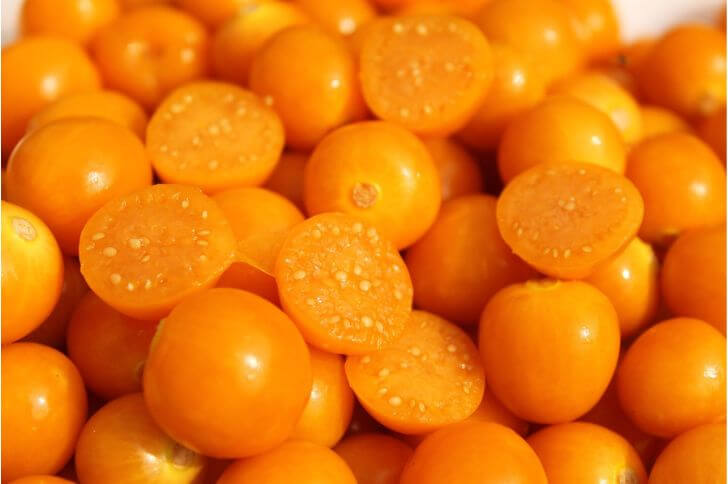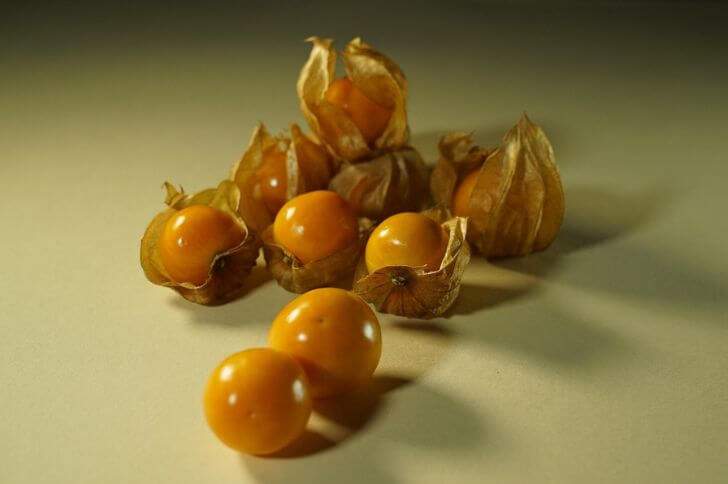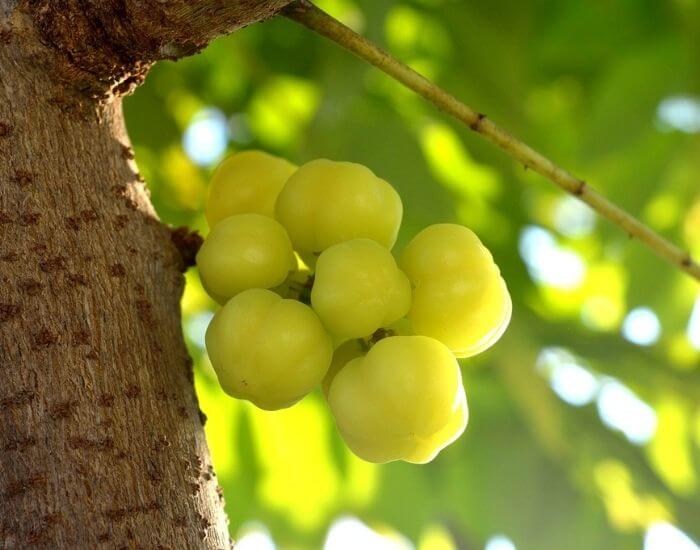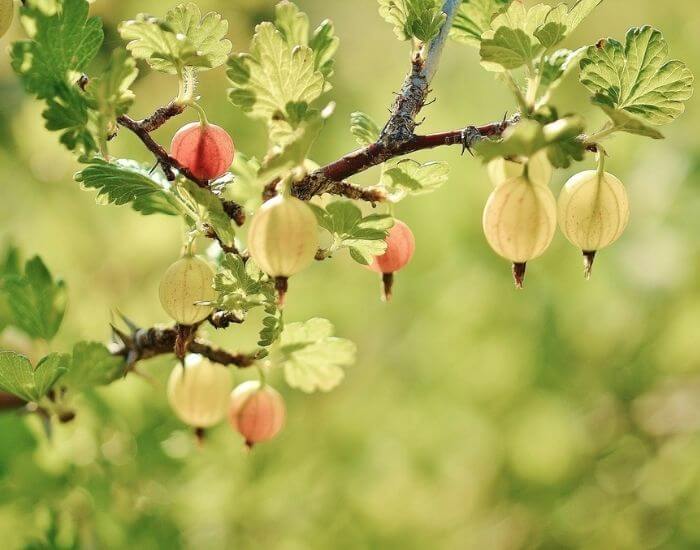Originating from the Andes region of South America, the uchuva is a small golden fruit that has a unique taste and numerous benefits.
Like most fruits, this small yellow fruit has different local names. In Hawaii it’s known as the poha berry, in Spanish it is called uchuva, uvilla or aguaymanto, and golden gooseberries and cape gooseberries in english.
Whether you are curious about trying uchuva for the first time or seeking to expand your knowledge on this extraordinary fruit, this article aims to provide a comprehensive guide to all things uchuva.
Uchuva cultivation
Golden gooseberries thrive in warm climates with plenty of sunlight, making them ideal for regions such as California and parts of the southern United States.
They can be grown both in containers and directly in the ground. To start growing golden gooseberries, it is recommended to plant young seedlings or purchase established plants from a nursery.
Cape gooseberry fruit color
The small round berries are encased in a papery husk that turns from green to golden yellow as the fruit ripens. The striking hue of the gooseberries makes them not only visually appealing but also adds a delightful pop of color to any dish or dessert.
The golden color is also indicative of its ripeness and sweetness. As the berries mature, they develop a luscious golden tone, signaling that they are ready to be enjoyed.
This hue not only enhances their visual appeal but also reflects their flavor profile – sweet with a hint of tanginess.
How to prepare uchuva fruit
Firstly, start by selecting ripe gooseberries that have a vibrant yellow-orange color and feel slightly soft when touched.
Next, remove the outer papery husk by gently peeling it away from the fruit. Rinse the poha under cold water.
After cleaning the fruits, you can either consume them fresh or incorporate them into various dishes.
Where does aguaymanto fruit come from?
As we said earlier, this small fruit originates from the Andes region of South America (Colombia, Peru, Ecuador, and Chile) and belongs to the nightshade family. The unique environmental conditions found in the Andes mountains provide an ideal habitat for uchuva plants to grow.
And, it has now spread to other parts of Africa, Asia, and Australia. Today, uchuva fruits are commercially grown in various countries around the world due to their increasing popularity.
Nutritional facts
Despite its small size, uchuva packs a punch when it comes to nutritional value. This fruit is low in calories and fat but rich in fiber.
Additionally, the aguaymanto fruit is a good source of vitamins K, A, and C.
Furthermore, one cup of these berries contains about 53 calories, no sodium or cholesterol.
When is uchuva fruit in season
The peak season for the Peruvian groundcherry depends on the specific region where it is grown. In countries like Colombia, Peru, Ecuador, and Chile, uchuvas are typically harvested between January and May.
These months coincide with the warmer seasons in these areas, providing optimal growing conditions for this tropical fruit.
In England, these small cherries fruit in August while in Africa harvesting begins in April extending to June.
What does aguaymanto fruit go in?
Due to its tangy and slightly sweet flavor, it is commonly used in desserts and baked goods. One popular option is incorporating uchuva fruit into pies and tarts, where its vibrant color and refreshing taste adds a unique twist to traditional recipes.
In addition to desserts, uchuva fruit can be utilized in savory dishes as well. Its citrusy notes make it an excellent ingredient for salsas and chutneys, adding a punch of flavor to grilled meats or roasted vegetables.
The tropical taste of the cape gooseberry also pairs well with seafood dishes like ceviche or shrimp tacos, providing a burst of freshness.
Cape gooseberry taste

When it comes to its taste, uvilla offers a unique flavor profile that is both sweet and tangy. The initial sensation on the palate is one of sweetness, reminiscent of a combination of tropical fruits (pineapple, mango and figs).
However, this sweetness quickly gives way to a tartness that resembles the taste of citrus fruits such as grapefruit.
The combination of these contrasting flavors makes uchuva a delightful treat for those who enjoy experiencing a range of tastes in one bite. The fruit is often described as having a refreshing and vibrant quality due to its balance between sweetness and tanginess.
Additionally, some people note subtle hints of tomato-like acidity in the flavor profile. Overall, uchuva fruit provides an exciting culinary experience for those willing to explore new and exotic tastes.
In terms of texture, the aguaymanto has a thin outer skin that encases the juicy flesh inside. The skin itself has an interesting texture – slightly papery yet delicate enough to be easily bitten into.
Once you break through the skin, you are greeted with tiny yellow seeds surrounded by translucent pulp. The pulp has a jelly-like consistency similar to grapes or cherry tomatoes but is firmer than typical berries like blueberries or raspberries.
This unique texture adds another dimension to the overall sensory experience when enjoying this yellow fruit.
How to eat uchuva
This small fruit is often consumed raw due to its sweet and tangy flavor, but there are various other ways to enjoy this delicious fruit.
Poha berry recipes

Cape gooseberry jam
Ingredients:
- 2 cups cape gooseberries
- cup sugar
- 1 lemon, juiced
Instructions:
- Start by cleaning the cape gooseberries.
- In a pot, combine the cape gooseberries, sugar, and lemon juice.
- Heat until it boils
- Reduce heat to low and simmer for about 20 minutes, stirring occasionally.
- Remove from heat and let the jam cool slightly before transferring it into sterilized jars.
- Seal the jars tightly and store in the refrigerator for up to three weeks. Enjoy!
Uchuva pie
Ingredients:
- 2 cups uchuva
- 1 cup granulated sugar
- 2 tablespoons all-purpose flour
- 1 teaspoon lemon zest
- 1 tablespoon butter, diced
- 1 double pie crust
Instructions:
- Preheat the oven to 425°F (220°C).
- In a bowl, combine uchuvas, sugar, flour, and lemon zest.
- Roll out one pie crust and line a pie plate with it.
- Pour the gooseberry mixture into the crust-lined plate.
- Dot the top with diced butter.
- Roll out the second pie crust and place it on top of the filling.
- Trim and seal the edges of the crusts together.
- Cut slits in the top for ventilation.
- Bake for about 30 minutes or until golden brown.
- Allow to cool before serving, and enjoy!
Gooseberry crumble
Ingredients:
- 4 cups of cape gooseberries
- 1 cup of flour
- 1/2 cup of sugar
- 1/2 cup of butter
Instructions:
- Preheat the oven to 375°F (190°C).
- Rinse and remove any stems from the gooseberries.
- Mix flour and sugar.
- Cube butter and add to the flour mixture.
- Use your fingers or a fork to blend the butter into the flour until it resembles coarse crumbs.
- Place the gooseberries in a baking dish and sprinkle the crumble mixture evenly over them.
- Bake until the gooseberries are soft and the top is golden brown
- Allow to cool slightly before serving. Enjoy!
Uchuva Drinks
One simple way to enjoy uchuva is by making a delicious smoothie. Blend together a handful with your favorite yogurt, a splash of orange juice, and some ice cubes.
The result is a creamy and tangy smoothie bursting with tropical flavors. For an extra boost of nutrition, you can add other fruits like mango or pineapple to the mix.
Another delightful way to incorporate uchuva into your drinks is by infusing it in water. Simply cut some fresh uchuva fruits in half and add them to a pitcher of cold water. Allow the flavors to infuse for at least an hour before serving over ice.
This infused water not only looks visually appealing but also offers a subtly sweet and refreshing taste that will quench your thirst.
Storage
Storing uchuva fruit is essential to maintain its freshness and extend its shelf life. One way to store it is by placing it in a cool, away from direct sunlight.
Uchuvas should be stored at room temperature, preferably between 50-60 degrees Fahrenheit.
When you have an abundant harvest from your garden or you bought them in bulk from the farmers market, freezing cape gooseberries is an excellent way to extend their shelf life and enjoy their refreshing taste all year round.
Firstly, it’s crucial to select ripe and firm cape gooseberries for freezing. Choose fruits that have a vibrant orange color and are free from any blemishes or damage.
Start by removing the husks carefully while ensuring not to squish or damage the delicate berries inside. Rinse them gently under cold water to remove any dirt or debris.
You can also can uchuvas. To start, gather your fresh gooseberries and ensure they are ripe but still firm. Wash them thoroughly.
Next, prepare your canning jars by washing them with warm soapy water and sterilizing them either in boiling water or using a dishwasher with a sanitize cycle.
Once the jars are clean and ready, it’s time to make the syrup that will give your canned gooseberries their delicious flavor. Combine equal parts of sugar and water in a saucepan over medium heat until the sugar completely dissolves.
Let the syrup cool and put it in jars.
Buying cape gooseberries
Where can I get uchuvas? Firstly, you can check specialty grocery stores that offer a wide variety of exotic fruits. These places often source their produce from different regions around the world to cater to diverse customer demands.
In addition to physical stores, online retailers also offer uchuva fruit for purchase. This option provides convenience for those who may not have access to local markets or prefer the ease of online shopping.
Cape gooseberry vs gooseberry
Uchuva is a small fruit that belongs to the nightshade family. It is native to South America. This fruit resembles a small yellow-orange cherry and is enclosed in a papery husk, which gives it an exotic appearance.
On the other hand, gooseberries are round or oval fruits that come in various colors, including green, red, and yellow.
Unlike cape gooseberries, gooseberries do not have a papery husk and are slightly larger in size.
While both cape gooseberries and regular gooseberries belong to the same family of plants, they differ significantly in terms of taste.
Cape gooseberries are often described as having a tropical sweetness with hints of pineapple or mango flavors when fully ripe.
On the contrary, traditional gooseberries have a more tangy and sour taste that some people might find refreshing or even slightly acidic.
Why do golden berries feel slimy?
When you bite into a golden berry, you may notice that it feels slimy or slippery on the surface. This sliminess can be attributed to the natural pectin content found in these fruits.
Pectin is a type of soluble fiber that is commonly found in many fruits and vegetables, and it acts as a thickening agent when heated. In the case of golden berries, the pectin gives them their characteristic slimy texture.
Additionally, the high water content of golden berries contributes to their sliminess. These fruits contain about 90% water, which helps to keep them hydrated and juicy.
When you bite into a golden berry, some of this water is released onto your tongue, creating a slippery sensation. The combination of pectin and water gives golden berries their distinct texture that some people find off-putting while others enjoy.
Are cape gooseberry leaves edible?
While the fruit of uchuva is commonly consumed and used in various culinary dishes, you may be wondering if its leaves are edible as well. The answer is yes, aguaymanto leaves can be eaten and are often used in herbal tea preparations.
Final Thoughts:
Cape gooseberries are a versatile fruit that offer a multitude of benefits and culinary possibilities. Whether eaten fresh, used in jams and desserts, or incorporated into savory dishes, these berries add a burst of flavor and nutrition to any meal.
So why not give these little golden gems a try? Visit your local farmer’s market or grocery store and discover the delightful taste and numerous benefits of uchuvas for yourself. Your taste buds will be grateful!
sources:
Hi There,
My name is Jenny. I’m the Chief Editor at Try Green Recipes and besides making yummy and healthy foods for my kids, grandkids, and friends. I’m new to the blogging world but I believe what I have to share is unique and will bring joy to your home. If you are adventurous and want try something tasty, let’s get started.

